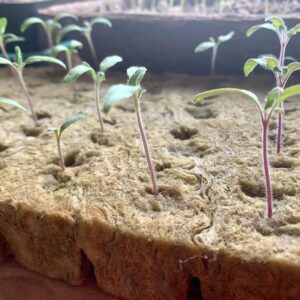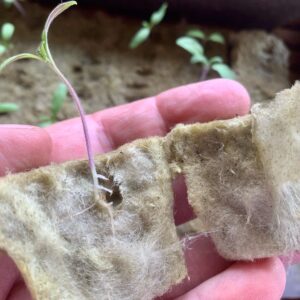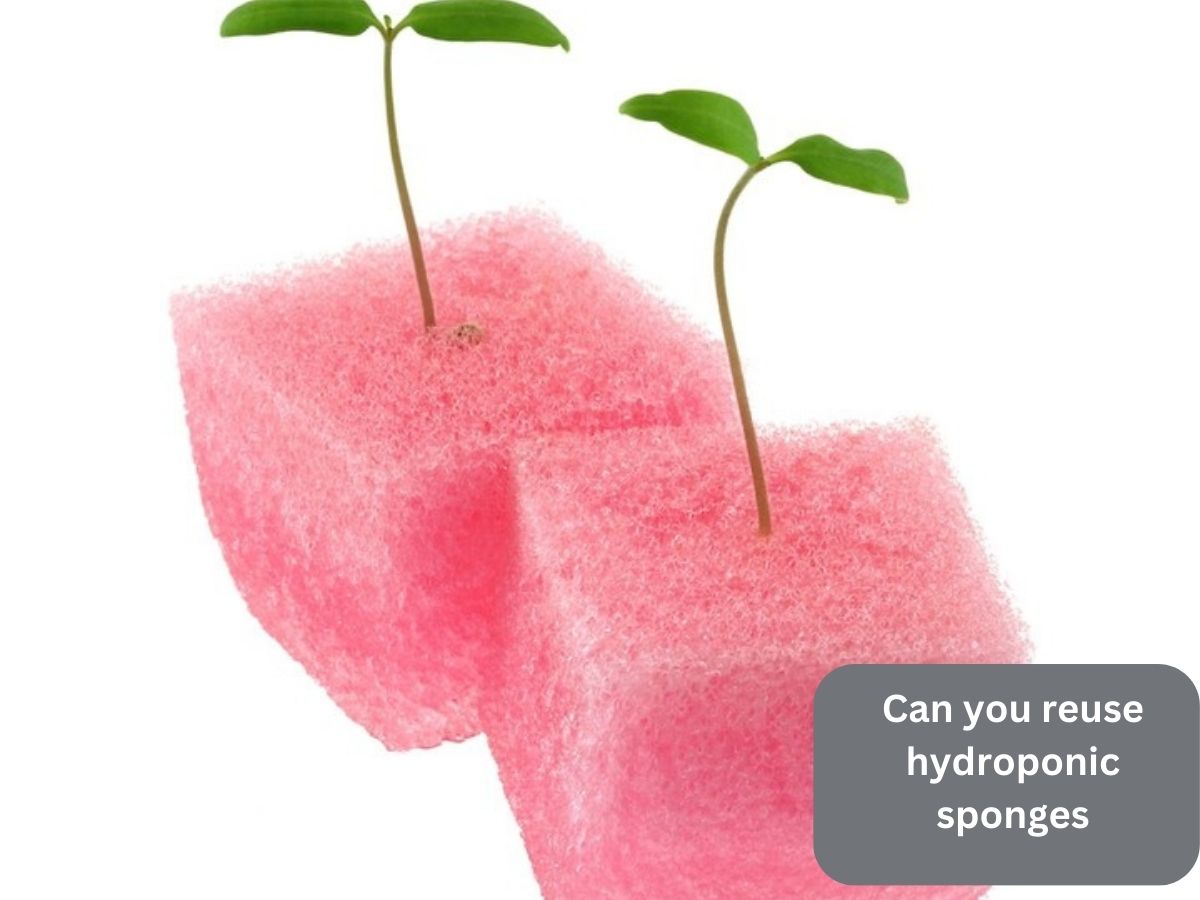Can you reuse hydroponic sponges? It’s a question that many hydroponic growers ponder, and the answer might surprise you. Hydroponic gardening has gained popularity due to its resource efficiency and ability to yield healthy, vibrant crops. Among the essential components of a successful hydroponic system are the growth media, with hydroponic sponges being a popular choice. But are these sponges a one-and-done deal, or can they be reused for multiple crop cycles?
In short, the answer is yes, you can reuse hydroponic sponges; Reusing sponges offers numerous benefits, such as cost-effectiveness and reduced environmental impact. However, like all good things, there are considerations to keep in mind. Proper cleaning and sanitization between crop cycles are vital to prevent potential risks like pathogen buildup and nutrient imbalances.
In this blog, we’ll delve into the world of hydroponic sponges, exploring how to effectively reuse them, which types are best suited for the task, and the common mistakes to avoid. Let’s unlock the secrets to successful hydroponic sponge recycling and take your gardening game to the next level!
What are hydroponic sponges?
Hydroponic sponges are a type of growing medium used in hydroponic systems. They are made of a porous material that provides a stable and consistent environment for plant growth. There are several different types of hydroponic sponges available, including rockwool, oasis cubes, and peat moss plugs.
Rockwool is one of the most commonly used hydroponic sponges. It is made from volcanic rock that has been melted and spun into fibers, creating a sponge-like material that can hold water and nutrients.
Oasis cubes are another popular type of hydroponic sponge, made from foam that is similar to what is used in floral arrangements. Peat moss plugs are another option, made from compressed peat moss that has been formed into small cubes or plugs.
Regardless of the type of hydroponic sponge used, they all function similarly. The sponge provides a stable environment for the plant’s roots to grow and absorb nutrients.
The sponge is also able to hold water and nutrients, ensuring that the plant always has access to what it needs. In a hydroponic system, the sponge is typically placed in a net pot or other container, with the plant’s roots growing out of the sponge and into the nutrient solution.
Can Hydroponic Sponges Be Reused?
Yes, hydroponic sponges can definitely be reused. In fact, reusing sponges can be a great way to save money and reduce waste in your hydroponic system. However, it is important to properly clean and sanitize the sponges to avoid any potential contamination issues.
To properly clean and sanitize hydroponic sponges for reuse, begin by removing any remaining plant material or debris from the sponge. This can be done by gently rinsing the sponge in water or using a soft brush to remove any stubborn debris.
Next, soak the sponge in a solution of hydrogen peroxide and water for several hours, making sure the sponge is fully submerged. The solution should be a 3% concentration of hydrogen peroxide to water.
After soaking, rinse the sponge thoroughly in clean water and let it air dry completely before reusing it in your hydroponic system. It’s important to note that some types of hydroponic sponges, such as rockwool, may require a longer soak time to properly sanitize. In general, it’s best to follow the manufacturer’s instructions for cleaning and reusing hydroponic sponges.
To extend the lifespan of your hydroponic sponges, it’s also important to handle them carefully and avoid damaging them during use. Be gentle when inserting and removing plants from the sponges, and try to avoid tearing or damaging the sponge material. You can also use a light bleach solution to sanitize the sponges after each use, although this should be done sparingly to avoid damaging the sponge material.
Overall, with proper care and sanitation, hydroponic sponges can be reused multiple times, saving you money and reducing waste in your hydroponic system.

Benefits of Reusing Hydroponic Sponges
Reusing hydroponic sponges offers several benefits, both financially and environmentally. Here are some advantages of reusing hydroponic sponges:
- Cost-effectiveness: By reusing hydroponic sponges, you can significantly reduce the operational costs of your hydroponic setup. Instead of buying new sponges for each crop cycle, you can clean and sanitize the existing sponges, making them ready for use in the next planting.
- Environmental sustainability: Reusing hydroponic sponges reduces waste generation, which contributes to a more environmentally friendly approach to agriculture. It helps minimize the use of resources and reduces the burden on landfills.
- Consistency in growth media: When you reuse sponges, you maintain consistency in the growth media’s physical properties, such as air porosity, water retention, and nutrient availability. This can positively impact plant growth and overall crop yields.
- Time-saving: Reusing sponges can save time in the preparation phase of each crop cycle. Cleaning and sanitizing the sponges are usually quicker compared to sourcing and setting up new sponges.
- Pathogen management: Reusing hydroponic sponges requires proper cleaning and disinfection between crops, which can help manage and prevent the spread of pathogens. This practice enhances the overall health of the plants and reduces the risk of diseases affecting your hydroponic system.
- Reduced contamination risk: New sponges may sometimes contain contaminants from manufacturing processes or storage. When you reuse sponges, you eliminate this risk as you already know the history of the sponge and can ensure its cleanliness.
- Familiarity with media performance: Over time, you become familiar with the specific performance of the sponges you are using. This knowledge allows you to better adjust your hydroponic system parameters, leading to optimized plant growth and improved yields.
Despite the benefits, it’s essential to keep in mind that reusing hydroponic sponges requires proper cleaning and sanitization between crop cycles. Regular maintenance and hygiene practices are crucial to ensuring healthy plant growth and preventing any potential issues with the root zone.ng hydroponic sponges, from cost savings and environmental benefits to improved plant growth.
By taking care to clean and sanitize sponges between uses properly, growers can maximize the lifespan of their sponges and enjoy these benefits over time.
Potential Risks of Reusing Hydroponic Sponges
While there are benefits to reusing hydroponic sponges, there are also potential risks associated with this practice. It’s important to be aware of these risks and take appropriate measures to mitigate them. Here are some potential risks of reusing hydroponic sponges:
- Disease and pathogen buildup: Reusing sponges without proper cleaning and sanitization can lead to the buildup of disease-causing pathogens and harmful microorganisms. If not adequately managed, these pathogens can spread and infect the new crop, leading to reduced plant health and lower yields.
- Nutrient imbalances: Over time, sponges can accumulate excess nutrients or salt residues from previous crops. These accumulated nutrients can disrupt the nutrient balance in the hydroponic system, affecting plant growth and potentially leading to nutrient deficiencies or toxicities in the new crop.
- Reduced air and water holding capacity: Repeated use of hydroponic sponges can cause them to degrade and lose their air and water holding capacity. This can impact the root’s oxygen availability and water retention, leading to stressed plants and poor growth.
- Physical degradation: With each use, hydroponic sponges can break down and become less effective as a growth medium. They may lose their structure, leading to poor root support and potential root damage.
- Accumulation of non-biodegradable substances: Some hydroponic sponges are made of synthetic materials that may not easily biodegrade. Over time, these non-biodegradable substances can accumulate in the hydroponic system and potentially cause long-term environmental issues.
- Cross-contamination: If sponges are not properly cleaned and sanitized between crop cycles, there is a risk of cross-contamination from one crop to another. This can lead to the spread of pests, diseases, and pathogens, affecting the overall health of the hydroponic system.
To minimize these risks, it is essential to implement proper maintenance and hygiene practices when reusing hydroponic sponges:
- Clean and sanitize sponges thoroughly between crop cycles to eliminate any potential pathogens and residues.
- Monitor nutrient levels in the hydroponic system regularly to prevent nutrient imbalances.
- Inspect sponges for signs of degradation and replace them as needed to ensure adequate support for plant roots.
- Consider using biodegradable or compostable sponges to reduce long-term environmental impacts.
- Implement a crop rotation plan and avoid planting susceptible crops in succession to reduce the risk of disease buildup.
By being proactive and attentive to these potential risks, you can effectively reuse hydroponic sponges while maintaining a healthy and productive hydroponic growing system.
How many times can hydroponic sponges be reused?
The number of times hydroponic sponges can be reused depends on various factors, including the quality of the sponges, the type of crops being grown, and the level of maintenance and cleaning they receive between crop cycles. There is no fixed or universal number of times sponges can be reused, as they can vary from one hydroponic system to another. However, here are some general guidelines:
- Quality of the sponges: High-quality sponges made from durable materials tend to withstand multiple uses better than cheaper, lower-quality alternatives. Sponges that maintain their structural integrity and don’t break down quickly can be reused more times.
- Crop types: Different crops have different root systems, and some crops can be more demanding on the growth medium than others. For example, fast-growing and aggressive plants may require more frequent sponge replacements compared to slow-growing plants with less extensive root systems.
- Maintenance and cleaning: Proper maintenance and regular cleaning are crucial to extending the lifespan of hydroponic sponges. Thoroughly cleaning and sanitizing the sponges between crop cycles can help reduce the buildup of pathogens, salts, and nutrient imbalances that might otherwise limit their reuse.
- Signs of wear and degradation: Monitor the condition of the sponges closely. If you notice significant wear, tear, or degradation, it may be time to replace them. Damaged or degraded sponges might not provide adequate support for plant roots or may harbor harmful pathogens.
- Personal preference: Some hydroponic growers may have specific practices or preferences when it comes to reusing sponges. Some growers may choose to reuse sponges for a set number of times (e.g., 2-3 cycles) regardless of their condition, while others may replace them more frequently.
In general, hydroponic sponges can be reused for multiple crop cycles if they are well-maintained, cleaned, and remain in good condition.
However, it is essential to pay attention to the condition of the sponges and regularly assess their effectiveness to ensure optimal plant growth and minimize the risk of disease or nutrient imbalances. Here is a detailed guide on how to grow root vegetables in hydroponics.
When sponges show signs of deterioration or become a potential source of problems in the hydroponic system, it’s time to consider replacing them with fresh sponges to support healthy plant growth.

How do I properly clean and sanitize hydroponic sponges for reuse?
Properly cleaning and sanitizing hydroponic sponges is essential to ensure the health of your plants and prevent the buildup of pathogens and contaminants. Here’s a step-by-step guide to help you clean and sanitize hydroponic sponges for reuse:
- Remove the Sponges: Remove the used sponges from the hydroponic system, taking care not to damage the roots of the plants.
- Rinse with Water: Rinse the sponges thoroughly with clean, running water. This step helps remove any loose debris and excess nutrients from the sponges.
- Soak in a Cleaning Solution: Prepare a cleaning solution by mixing water with a mild detergent or a specialized hydroponic cleaning solution following the manufacturer’s instructions. Submerge the sponges in the cleaning solution and let them soak for about 30 minutes to one hour.
- Scrub Gently: After soaking, use a soft brush or your hands to gently scrub the sponges, removing any remaining debris or residue. Be careful not to damage the sponges during this process.
- Rinse Thoroughly: Once you’ve scrubbed the sponges, rinse them thoroughly with clean water to remove any traces of the cleaning solution.
- Disinfect with a Sanitizing Solution: Prepare a sanitizing solution using either a hydrogen peroxide solution (3% concentration) or a diluted bleach solution (1 part bleach to 9 parts water). Submerge the sponges in the sanitizing solution and let them soak for 10-15 minutes. Alternatively, you can use commercial disinfectants formulated for hydroponic systems.
- Rinse Again: After sanitizing, rinse the sponges thoroughly with clean water to remove any remaining traces of the sanitizing solution.
- Dry the Sponges: Allow the sponges to dry completely before reusing them. You can place them in a well-ventilated area or use a fan to speed up the drying process.
- Inspect and Store: Inspect the sponges for any signs of damage or degradation. If the sponges are still in good condition, store them in a clean and dry area until you’re ready to use them again.
- Monitor pH and EC: Before using the sponges with new plants, check the pH and electrical conductivity (EC) of the sponges to ensure they are within the appropriate range for your chosen crops.
Remember to follow safety guidelines when handling cleaning and sanitizing solutions, as some chemicals can be harmful. Always wear appropriate protective gear and handle the solutions in a well-ventilated area.
Regularly cleaning and sanitizing hydroponic sponges between crop cycles will help maintain a healthy and disease-free growing environment, promoting optimal plant growth and higher yields.
Can You Reuse Hydroponic Sponges FAQs?
Can all types of hydroponic sponges be reused?
Not all types of hydroponic sponges are designed for reuse, as their durability and structure can vary. Some sponges are specifically labeled as single-use, and attempting to reuse them may result in poor plant growth or contamination risks.
However, many high-quality hydroponic sponges made from materials such as rockwool, oasis cubes, or specialized foam can be reused effectively if maintained properly.
It is crucial to check the manufacturer’s guidelines or product specifications to determine if the sponges you are using are suitable for reuse.
Can you reuse sponges with different plants?
Yes, hydroponic sponges can be reused with different plants, but it’s essential to consider a few factors. Plants with similar growth requirements and root systems are generally more suitable for consecutive reuse of the same sponges.
For example, using sponges for different types of leafy greens or herbs is more feasible than transitioning from tomatoes to cucumbers, as these plants have different root system demands and nutrient requirements.
It’s crucial to clean and sanitize the sponges thoroughly between crop cycles to prevent the transfer of pathogens and ensure a fresh start for the new plants. Crop rotation can also help reduce the risk of disease buildup when reusing sponges with different plants.
Do reused hydroponic sponges affect plant growth?
If properly cleaned, sanitized, and maintained, reused hydroponic sponges should not significantly affect plant growth. However, several factors can impact plant growth when reusing sponges:
- Pathogen buildup: If sponges are not adequately cleaned and sanitized, pathogens can accumulate and negatively affect plant health, leading to stunted growth or disease.
- Nutrient imbalances: Reused sponges may retain excess salts or nutrients from previous crops, potentially causing nutrient imbalances that can harm new plants.
- Physical degradation: Sponges that have been used multiple times might lose their structural integrity, affecting root support and aeration, which can impact plant growth.
To ensure optimal plant growth when reusing hydroponic sponges, it’s crucial to follow proper cleaning and maintenance procedures, closely monitor plant health, and address any issues promptly.
What are some common mistakes to avoid when reusing hydroponic sponges?
- Inadequate cleaning and sanitization: Failing to clean and sanitize sponges thoroughly between crop cycles can lead to the buildup and spread of pathogens, negatively impacting plant health.
- Ignoring signs of wear and degradation: Continuously reusing sponges that are visibly damaged or degraded can affect root support and air-water balance, hindering plant growth.
- Cross-contamination: Using sponges without proper cleaning between different crops can lead to cross-contamination, causing the spread of pests, diseases, and pathogens.
- Neglecting pH and nutrient balance: Not monitoring and adjusting pH levels and nutrient solutions in the hydroponic system can lead to nutrient imbalances that affect plant growth.
- Overlooking crop rotation: Planting the same or similar crops consecutively in reused sponges can lead to disease buildup and reduced plant health.
- Using non-reusable sponges: Attempting to reuse single-use sponges can lead to poor plant growth and may not be cost-effective.
By being aware of these common mistakes and taking appropriate measures to address them, you can maximize the benefits of reusing hydroponic sponges and promote healthy and productive plant growth in your hydroponic system.
ConclusionIn
reusing hydroponic sponges can offer significant benefits, such as cost-effectiveness, reduced waste, and environmental sustainability. Properly cleaning and sanitizing the sponges between crop cycles are essential to avoid potential risks, including pathogen buildup, nutrient imbalances, and physical degradation.
High-quality sponges, when well-maintained, can be reused effectively, supporting healthy plant growth. While some hydroponic sponges are designed for single use, many durable types, such as rockwool or oasis cubes, can be reused multiple times.
However, it is crucial to follow best practices, including crop rotation and pH/nutrient monitoring, to ensure optimal results. Avoiding common mistakes, such as neglecting cleaning or using damaged sponges, is vital to maximizing the advantages of reusing hydroponic sponges and creating a thriving and productive hydroponic growing environment.
